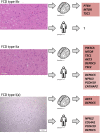Genotype-phenotype correlations in focal malformations of cortical development: a pathway to integrated pathological diagnosis in epilepsy surgery
- PMID: 30485578
- PMCID: PMC8028510
- DOI: 10.1111/bpa.12686
Genotype-phenotype correlations in focal malformations of cortical development: a pathway to integrated pathological diagnosis in epilepsy surgery
Abstract
Malformations of cortical development (MCD) comprise a broad spectrum of developmental brain abnormalities. Patients presenting with MCDs often suffer from drug-resistant focal epilepsy, and some become candidates for epilepsy surgery. Their likelihood of achieving freedom from seizures, however, remains uncertain, and depends in a major part on the underlying pathology. Tissue samples obtained in epilepsy surgery form the basis of definite histopathological diagnosis; however, new molecular genetic methods have not yet been implemented in diagnostic processes for MCD cases. Furthermore, it has not been completely understood how the underlying pathology affects patients' outcomes after epilepsy surgery. We performed a systematic literature review of studies describing both histopathological and molecular genetic findings in MCD, along with studies on epilepsy surgery outcomes. We aimed to correlate the genetic causes with the underlying morphological abnormalities in focal cortical malformations and to stress the importance of the underlying biology for patient management and counseling. From the summarized findings of multiple authors, it is obvious that MCD may have a diverse genetic background despite a similar or even identical histopathological picture. Even though most of their molecular genetic findings converge on various levels of the PI3K/AKT/mTOR pathway, the exact mechanisms underlying MCD formation have not yet been completely described or indeed how this pathway generates a diverse range of histological abnormalities. Based on our findings, we therefore propose that all patients diagnosed and operated for drug-resistant epilepsy should have an integrated molecular and pathological diagnosis similar to the current practice in brain tumor diagnostic processes that might lead to more accurate diagnosis and effective stratification of patients undergoing epilepsy surgery.
Keywords: mTOR; epilepsy surgery; malformations of cortical development; neuropathology; somatic variant.
© 2018 International Society of Neuropathology.
Figures



Comment in
-
It is time to move on: Commentary to: Genotype-phenotype correlations in focal malformations of cortical development: a pathway to integrated pathological diagnosis in epilepsy surgery (DOI: 10.1111/bpa.12686).Brain Pathol. 2019 Jul;29(4):467-468. doi: 10.1111/bpa.12714. Epub 2019 Mar 13. Brain Pathol. 2019. PMID: 30868684 Free PMC article. No abstract available.
References
-
- Barba C, Jacques T, Kahane P, Polster T, Isnard J, Leijten FS et al (2013) Epilepsy surgery in neurofibromatosis type 1. Epilepsy Res 105:384–395. - PubMed
-
- Baulac S (2014) Genetics advances in autosomal dominant focal epilepsies: focus on DEPDC5. Prog Brain Res 213:123–139. - PubMed
-
- Baulac S, Ishida S, Marsan E, Miquel C, Biraben A, Nguyen D et al (2015) Familial focal epilepsy with focal cortical dysplasia due to DEPDC5 mutations. Ann Neurol 77:675–683. - PubMed
Publication types
MeSH terms
Substances
Grants and funding
LinkOut - more resources
Full Text Sources
Medical
Miscellaneous

